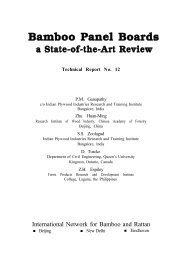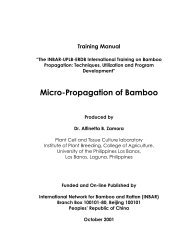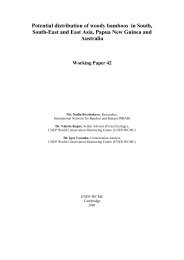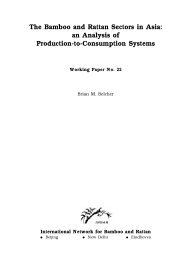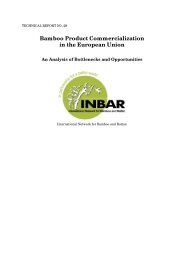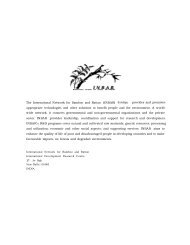ISSN ………… - International Network for Bamboo and Rattan
ISSN ………… - International Network for Bamboo and Rattan
ISSN ………… - International Network for Bamboo and Rattan
You also want an ePaper? Increase the reach of your titles
YUMPU automatically turns print PDFs into web optimized ePapers that Google loves.
4.2.4. Non-conventional pulping processes<br />
The non-conventional pulping processes include well-known pulping principles, which are, however,<br />
only rarely applied commercially. Their industrial application is often limited by high costs of<br />
chemicals <strong>and</strong> special equipment requirements. However, they posses the advantage of more<br />
environmental friendliness techniques. Appendix 4B gives a survey of different non-conventional<br />
pulping procedures. Pulping via sodium-xylene sulphonate, aqueous ethanol, ketone-ammonia<br />
mixture, ethanol amine, peracetic acid, oxygen-alkali, etc., are some of the ef<strong>for</strong>ts to develop pollution<br />
free pulping processes. Among the various processes, some commonly referred methods are described<br />
below :<br />
4.2.4.1. Ethanol-water pulping<br />
Aqueous ethanol is a powerful delignifying agent. Retention of lignin is strongly dependent on pH of<br />
the cooking liquor. After distilling off the alcohol from ethanol-water black liquor, a major fraction of<br />
the solubilized lignin separates as a quasi-molten phase.<br />
4.2.4.2. Hydrotropic pulping<br />
Certain substances which are only slightly soluble in water become more soluble in the presence of<br />
certain salts known as hydrotropic salts. These are salts of organic acids which have a large organic<br />
group <strong>and</strong> are themselves soluble in water. It has been shown that a near-saturated aqueous solution of<br />
sodium xylen sulphonate at approximately 70 0 C, will dissolve large quantities of lignin. These salts<br />
appear to act as catalysts. As they are not consumed, they can be recovered unchanged <strong>for</strong> reuse. Also<br />
they hydrolyse wood or straw at a much faster rate than the chemicals used in other processes of pulp<br />
making. In pulping with sodium xylene sulphonate, cooking could be accomplished in shorter time<br />
<strong>and</strong> at lower temperature than with other st<strong>and</strong>ard processes. For most woods the composition of the<br />
hydrotropic cooking solution is approximately one third salt <strong>and</strong> two thirds water; the solution is<br />
adjusted to a slightly acid pH (3.5). A typical cook, <strong>for</strong> paper bags takes 2-3 hrs. at 145 0 C <strong>and</strong> 4 bar<br />
pressure. At the end of the cook, the solution is filtered from the pulp <strong>and</strong> reused half a dozen times<br />
<strong>for</strong> other cooks. The solution is then diluted with warm water (40- 60 0 C) to a salt concentration of 8-<br />
10 per cent <strong>for</strong> precipitating the lignin. The lignin is removed by filtration <strong>and</strong> the solution is<br />
evaporated until the concentration of sodium xylenesulphonate is nearly 30 per cent; at this stage the<br />
solution can once again be used <strong>for</strong> cooking. The solution is nonscaling <strong>and</strong> noncorrosive <strong>and</strong> free<br />
from objectionable odour. The pulp is pressed to a consistency of about 40 per cent, washed free of<br />
the remaining hydrotropic salt. The properties of the pulp fall between those of an acid sulphite <strong>and</strong> an<br />
alkaline kraft pulp. The yield is 10 per cent higher <strong>and</strong> gives a high white colour in the usual<br />
bleaching processes.<br />
17



